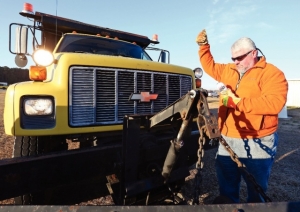Cold weather preparation begins at local DOT office
By Steve Herring
Published in News on December 3, 2014 1:46 PM

News-Argus/CASEY MOZINGO
Supervisor of section five J.M. Webb gives a signal to driver Jeff Hopper to lower the plow while testing winter weather equipment at the North Carolina Department of Transportation. The equipment has to be tested and lubricated so it is ready for snow and ice.
When it comes to long-range snow or ice forecasts, Luther Thompson jokes that some people he works with at the state Department of Transportation's Wayne County maintenance office turn to an almanac.
"The only forecast we get is the guys reading the almanac," he said. "We have a couple of guys out here who believe in the almanac. They told us last year when it was going to snow."
But regardless of the forecast or when the snow comes, his crews are ready to go to work, said Thompson, who supervises the office.
Preparation starts in October when the office conducts an equipment pre-trip, Thompson said.
"We hook everything up including the plows, the spreaders, the brine tank," he said. "We will make sure that everything is working and functioning like it is supposed to. Then what we do during our safety training class we go over our snow plan for the coming year.
"Most of the men will have the same route that they had last year. Then we have some new ones, or different ones who will have to switch around in the county doing different sections. So we go over these sections with them."
The crews review the county map and prioritize which roads will be cleared first.
"We always focus on the four-lane roads first, including (Interstate) 795, (U.S.) 70 and 117," Thompson said. "Then we go to work on our primary two-lane roads then we work on down to our secondary roads after that.
"That is what we usually do in October -- basically it is just checking everything out again, going over the routes with the guys and going over which roads we are going to focus on first. We try to be ready to go by the first of November."
The salt house has been stockpiled with about 1,100 tons of salt and the brine plant has been checked out and is ready to go, too, he said.
Thompson said he is unsure how much salt was used last year to treat the roads with brine and/or salt.
"I know we went through it last year," he said. "At the end of the season last year there was not much left in the house. I bet we had maybe 200 tons left. So I think there was maybe 1,200 to 1,300 tons. We probably used about 800 to 1,000 tons last year."
The office has seven trucks that have brine tanks.
Brine uses less salt, three pounds per gallon of water, while it takes 250 pounds per lane mile, he said. "That helps out a lot," Thompson said. "Then we have six trucks with salt spreaders. Some of the brine tank trucks can be switched out and a spreader attached."
Part of the preparation is to calibrate the equipment to ensure it is putting out the correct volume -- 40 gallons of brine per mile or 250 pounds of salt per mile with spreader.
"We have about 35 employees, and we work as a team," Thompson said. "We work in 12-hour shifts (during snow events). We have guys on the trucks. Then we have our bridge department, and their employees are working the salt house and making the brine for us. That is a full-time job right there just keeping up with the brine. That sort of frees us up so we can have our guys focused on the highways.
"Also we have contractors with us. We have a couple of contractors on a list for snow removal. They will come in with the graders and we will place the graders throughout the county. They help us out a lot because we are down to four graders. So you get another five or six graders coming in here, that has helped a lot."
